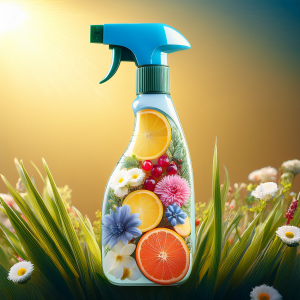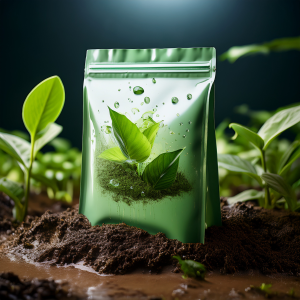As businesses increasingly prioritize environmental responsibility, eco-friendly cleaning products have become a cornerstone of modern workplace safety and sanitation. These sustainable solutions, formulated with natural, biodegradable ingredients, offer a compelling alternative to traditional cleaning products that often contain harmful chemicals. By adopting green cleaning practices, organizations can create healthier, safer environments for employees and customers while reducing their ecological footprint. This article explores the benefits of eco-friendly cleaning products, the innovations driving their adoption, and practical steps for businesses to make the transition, all grounded in science, regulatory standards, and real-world impact.
The Case for Green Cleaning: Why It Matters

The shift toward eco-friendly cleaning products is not just a trend; it’s a necessity driven by growing awareness of the health and environmental risks posed by conventional cleaners. Traditional cleaning products often contain volatile organic compounds (VOCs), ammonia, chlorine bleach, and other harsh chemicals that can have detrimental effects on both people and the planet. These substances can linger in the air, contaminate water systems, and pose long-term risks. In contrast, green cleaning products are designed to minimize these harms while delivering comparable, or even superior cleaning performance. Eco-friendly cleaning products by contrast:
1. Enhance Indoor Air Quality
One of the most immediate benefits of eco-friendly cleaning products is their ability to improve indoor air quality. As stated, conventional cleaners often release VOCs, which are chemical compounds that evaporate into the air and can cause a range of health issues, including headaches, dizziness, respiratory irritation, and eye discomfort; and that’s to say nothing of strong chemical odors.
Eco-friendly cleaning products certified by the EPA’s Safer Choice program must adhere to strict VOC limits, ensuring that they contribute minimally to indoor air pollution. This is especially important in settings like offices, schools, and healthcare facilities, where air quality directly impacts well-being.
2. Reduce Health Risks
Beyond air quality, green cleaning products significantly lower health risks associated with chemical exposure. Traditional cleaners often contain ingredients like ammonia, phosphates, and parabens, which can trigger allergic reactions, skin irritations, and respiratory problems. For individuals with asthma, allergies, or other sensitivities, these chemicals can worsen symptoms, making the workplace an uncomfortable or even hazardous environment. Moreover, accidental exposure to toxic residues through skin contact or ingestion can lead to chemical burns or poisoning, particularly in workplaces frequented by children or pets.

Eco-friendly cleaners, on the other hand, are typically made from natural, plant-based ingredients that are gentle on the body. For example, many green products use citrus extracts, vinegar, or essential oils as active ingredients, which are far less likely to cause irritation. These products also leave behind minimal residues, reducing the risk of accidental harm. In workplaces with diverse populations, such as schools, daycare centers, or pet-friendly offices, this safety advantage is invaluable.
3. Minimize Environmental Impact
The environmental benefits of green cleaning products are equally compelling. Conventional cleaners often contain chemicals like phosphates, which can wash into waterways and cause algal blooms that deplete oxygen levels and harm aquatic life. Chlorine, bleach, and ammonia, commonly found in traditional products, can also pollute soil and water, contributing to long-term ecological damage. Additionally, the plastic packaging of many conventional cleaners often ends up in landfills, worsening the global waste crisis.
Eco-friendly cleaning products use natural ingredients that are designed to break down after use, minimizing their impact on the environment. And many green cleaning brands also prioritize sustainable packaging, using materials like recycled plastics, compostable pouches, or even packaging-free options like dissolvable tablets. By reducing plastic waste these products help businesses contribute to a more sustainable future.
4. Meet High Performance Standards
A common misconception about green cleaning products is that they are less effective than their conventional counterparts. However, many eco-friendly cleaners are rigorously tested to ensure they meet high performance standards. Third-party certifications like Green Seal®, ECOLOGO, and the EPA’s Safer Choice label provide assurance that these products have been evaluated for both efficacy and environmental impact.
For example, the Green Seal® certification requires products meet strict criteria for pH balance to minimize skin and eye irritation, VOC content, and biodegradability. Similarly, the EPA’s Safer Choice program guarantees that certified products perform as well as or better than traditional cleaners while adhering to stringent safety guidelines. These certifications give businesses confidence that they are not sacrificing cleaning power for sustainability. In fact, many green products outperform conventional options in specific applications, such as grease removal or stain cleaning.
5. Align with Regulatory Standards and Transparency
Regulatory frameworks are increasingly encouraging the adoption of green cleaning products by setting strict standards for ingredients and labeling. For instance, the California Air Resources Board (CARB) regulates the amount of VOCs cleaning products can emit, protecting both indoor air quality and the environment. The EPA’s Safer Choice program goes a step further by requiring manufacturers to disclose key ingredients and avoid hazardous substances like parabens, ammonia, and chlorine bleach.
This transparency is the keystone of green cleaning. Businesses can make informed decisions by reviewing ingredient lists and certifications so they can choose the products that align with their safety and environmental goals. Compliance with these regulations also helps companies avoid potential fines or legal issues, while demonstrating a commitment to corporate responsibility, an increasingly important factor for customers and stakeholders.
Innovations in Green Cleaning: The Future of Sustainability
The green cleaning industry is rapidly evolving, with innovative products and practices that make sustainability more accessible and effective, such as:
Waterless and Soap-Free Cleaners: Some green cleaning products use natural antimicrobial agents, such as essential oils or enzymes, to clean surfaces without the need for water or traditional soap. These products reduce water usage and packaging waste while maintaining high cleaning efficacy, making them ideal for water-scarce environments or businesses looking to minimize their environmental footprint.

Concentrated Tablet Refills: A growing number of brands offer dissolvable cleaning tablets that can be mixed with water in reusable bottles. This innovation eliminates single-use plastics and reduces the carbon emissions associated with shipping heavy liquid cleaners. For example, a single tablet can replace a whole bottle of cleaner, making it a cost-effective and space-saving option for workplaces.
Plant-Based Surfactants: Surfactants help cleaners break down grease and dirt and are often derived from petroleum, which is a non-renewable resource. Green cleaning products lean towards plant-based surfactants like those derived from coconut or corn, which are biodegradable and just as effective. These alternatives reduce reliance on fossil fuels and ensure that the product breaks down with little harm to the environment.
How to Choose the Right Green Cleaning Products
Transitioning to eco-friendly cleaning products requires careful consideration to make sure the chosen solutions meet safety and performance needs. Here are key factors to evaluate when selecting products for your workplace:
Third-Party Certifications: Look for labels like EPA Safer Choice, Green Seal®, or ECOLOGO, which guarantee that the product has been tested for safety, efficacy, and environmental impact.
Ingredient Transparency: Choose products that disclose their ingredients and avoid known toxins such as phosphates, parabens, ammonia, and chlorine bleach.
Biodegradable Formulas: Check that the product is made from natural, plant-based ingredients that break down safely in the environment.
Sustainable Packaging: Opt for products with recyclable, compostable, or minimal packaging to reduce waste.
Reviews: When in doubt, see what others are saying and look for reviews from actual users.
A Smarter Path Forward
Eco-friendly cleaning products are more than a passing trend, they are a science-backed, practical solution for creating safer, more sustainable workplaces. These products empower businesses to protect their people and the planet without compromising on performance. As innovations continue to make green cleaning more accessible and effective, there has never been a better time for organizations to make the switch. By choosing eco-friendly cleaning solutions, businesses can lead by example, fostering healthier spaces and a more sustainable future for all.
Sources
- Environmental Protection Agency. (2023, November 30). Identifying greener cleaning products. U.S. Environmental Protection Agency. https://www.epa.gov/greenerproducts/identifying-greener-cleaning-products
- Green Seal. (2024). Cleaning products. Green Seal. https://greenseal.org/categories/cleaning-products/
- Practice Greenhealth. (2023). 10 steps to green cleaning implementation [PDF]. Practice Greenhealth. https://practicegreenhealth.org/sites/default/files/2019-02/greenclean10step.pdf
- Clean Water Action. (2024). Green cleaning guide. Clean Water Action. https://cleanwater.org/green-cleaning-guide
- Artworkflow HQ. (2024, February 8). Environmental compliance: Green cleaning product regulations. Artworkflow HQ. https://www.artworkflowhq.com/resources/environmental-compliance-green-cleaning-product-regulations
- U.S. Green Building Council. (2024). Green cleaning—products and materials. U.S. Green Building Council. https://www.usgbc.org/credits/existing-buildings-schools-existing-buildings-retail-existing-buildings-hospitality-exist-27

